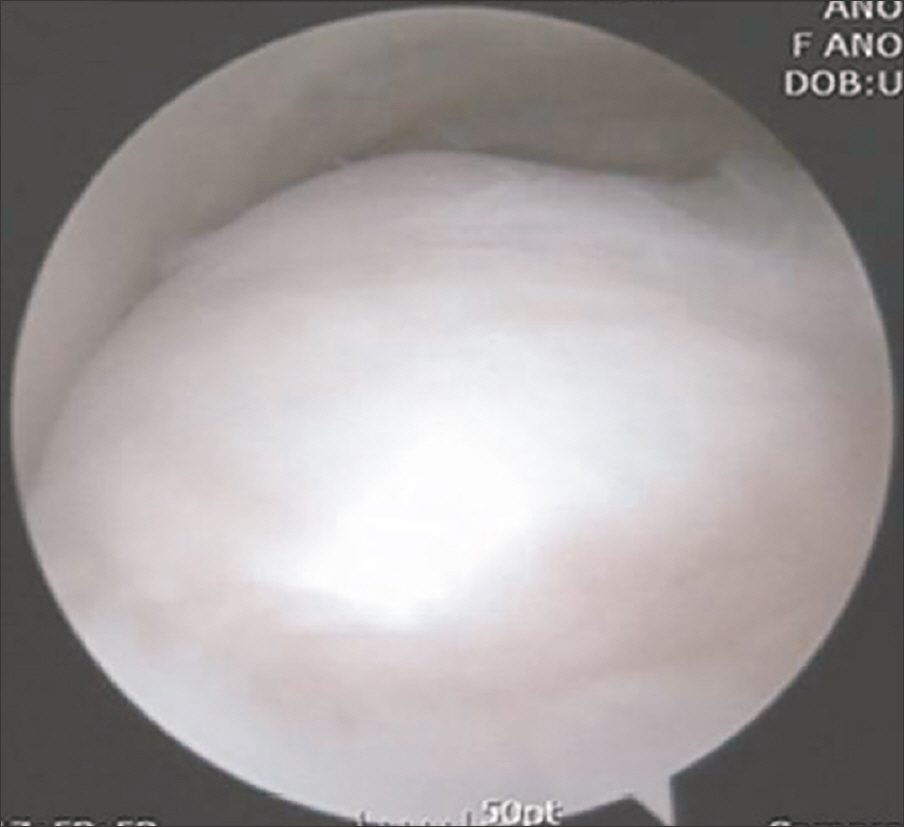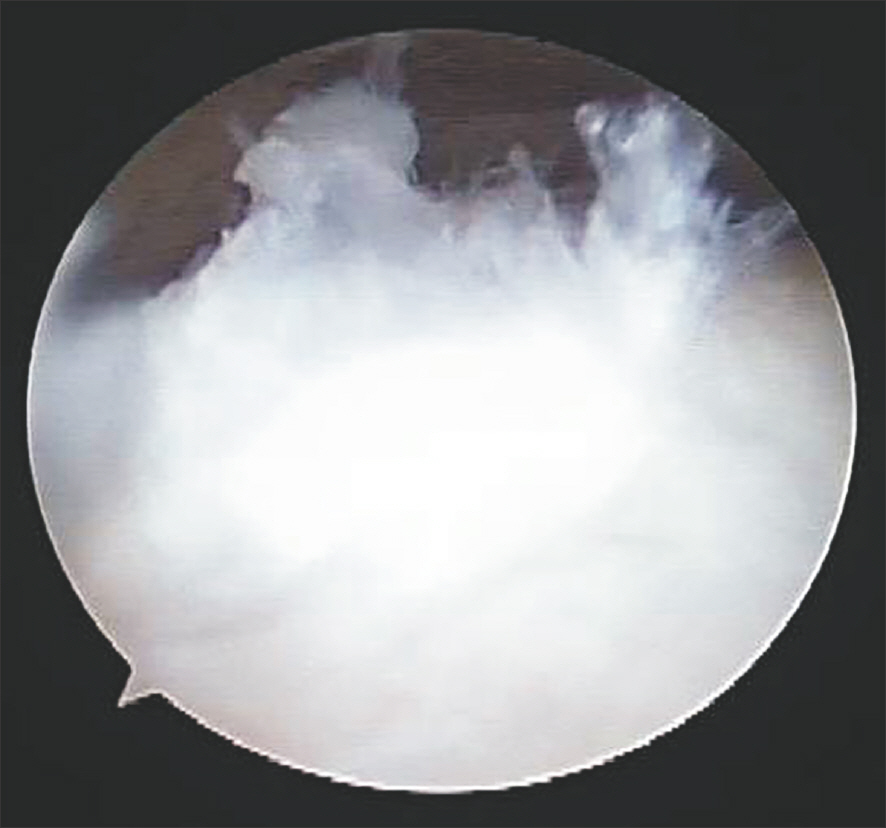J Korean Foot Ankle Soc.
2015 Jun;19(2):43-46. 10.14193/jkfas.2015.19.2.43.
Redomicrofracture as a Treatment for Osteochondral Lesion of Talus after the Failure of Arthroscopic Microfracture
- Affiliations
-
- 1Department of Orthopaedic Surgery, Yonsei University College of Medicine, Seoul, Korea. ljwos@yuhs.ac
- KMID: 1794881
- DOI: http://doi.org/10.14193/jkfas.2015.19.2.43
Abstract
- Arthroscopic treatment has been reported to provide effective improvement of ankle function when used in treatment of small osteochondral lesion of talus; however, favorable long-term results have been less predictable for large osteochondral lesion of talus. In cases in which primary arthroscopic treatment fails, the decision regarding which subsequent technique to choose has become increasingly difficult, as good clinical outcomes may be unlikely for such patients irrespective of the surgical technique used. Redomicrofracture should be used judiciously for treatment of osteochondral lesion of talus in which arthroscopic treatment has failed.
Figure
Cited by 1 articles
-
Supramalleolar Osteotomy Combined with Redo Arthroscopy for a Patient with Persistent Pain after Primary Arthroscopic Microfracture for Medial Osteochondral Lesion of the Talus: A Case Report
Tae Hun Song, Jin Soo Suh, Jun Young Choi
J Korean Foot Ankle Soc. 2023;27(2):71-74. doi: 10.14193/jkfas.2023.27.2.71.
Reference
-
1.Giannini S., Buda R., Faldini C., Vannini F., Bevoni R., Grandi G, et al. Surgical treatment of osteochondral lesions of the talus in young active patients. J Bone Joint Surg Am. 2005. 87(Suppl 2):28-41.
Article2.Kono M., Takao M., Naito K., Uchio Y., Ochi M. Retrograde drilling for osteochondral lesions of the talar dome. Am J Sports Med. 2006. 34:1450–6.
Article3.Easley ME., Latt LD., Santangelo JR., Merian-Genast M., Nunley JA 2nd. Osteochondral lesions of the talus. J Am Acad Orthop Surg. 2010. 18:616–30.
Article4.Ferkel RD., Scranton PE Jr., Stone JW., Kern BS. Surgical treatment of osteochondral lesions of the talus. Instr Course Lect. 2010. 59:387–404.5.Giannini S., Vannini F. Operative treatment of osteochondral lesions of the talar dome: current concepts review. Foot Ankle Int. 2004. 25:168–75.
Article6.Barnes CJ., Ferkel RD. Arthroscopic debridement and drilling of osteochondral lesions of the talus. Foot Ankle Clin. 2003. 8:243–57.
Article7.Choi WJ., Choi GW., Kim JS., Lee JW. Prognostic significance of the containment and location of osteochondral lesions of the talus: independent adverse outcomes associated with uncontained lesions of the talar shoulder. Am J Sports Med. 2013. 41:126–33.8.Choi WJ., Kim BS., Lee JW. Osteochondral lesion of the talus: could age be an indication for arthroscopic treatment? Am J Sports Med. 2012. 40:419–24.9.Choi WJ., Park KK., Kim BS., Lee JW. Osteochondral lesion of the talus: is there a critical defect size for poor outcome? Am J Sports Med. 2009. 37:1974–80.10.Lee KB., Bai LB., Yoon TR., Jung ST., Seon JK. Second-look ar-throscopic findings and clinical outcomes after microfracture for osteochondral lesions of the talus. Am J Sports Med. 2009. 37(Suppl 1):63S-70S.
Article11.Tol JL., Struijs PA., Bossuyt PM., Verhagen RA., van Dijk CN. Treatment strategies in osteochondral defects of the talar dome: a systematic review. Foot Ankle Int. 2000. 21:119–26.
Article12.van Bergen CJ., Kox LS., Maas M., Sierevelt IN., Kerkhoffs GM., van Dijk CN. Arthroscopic treatment of osteochondral defects of the talus: outcomes at eight to twenty years of follow-up. J Bone Joint Surg Am. 2013. 95:519–25.13.Chuckpaiwong B., Berkson EM., Theodore GH. Microfracture for osteochondral lesions of the ankle: outcome analysis and outcome predictors of 105 cases. Arthroscopy. 2008. 24:106–12.
Article14.Kreuz PC., Steinwachs MR., Erggelet C., Krause SJ., Konrad G., Uhl M, et al. Results after microfracture of full-thickness chondral defects in different compartments in the knee. Osteoarthritis Cartilage. 2006. 14:1119–25.
Article15.Mithoefer K., Williams RJ 3rd., Warren RF., Potter HG., Spock CR., Jones EC, et al. The microfracture technique for the treatment of articular cartilage lesions in the knee. A prospective cohort study. J Bone Joint Surg Am. 2005. 87:1911–20.16.Murawski CD., Foo LF., Kennedy JG. A review of arthroscopic bone marrow stimulation techniques of the talus: the good, the bad, and the causes for concern. Cartilage. 2010. 1:137–44.17.Valderrabano V., Leumann A., Rasch H., Egelhof T., Hintermann B., Pagenstert G. Knee-to-ankle mosaicplasty for the treatment of osteochondral lesions of the ankle joint. Am J Sports Med. 2009. 37(Suppl 1):105S-11S.
Article18.Saxena A., Eakin C. Articular talar injuries in athletes: results of microfracture and autogenous bone graft. Am J Sports Med. 2007. 35:1680–7.19.Yoon HS., Park YJ., Lee M., Choi WJ., Lee JW. Osteochondral autologous transplantation is superior to repeat arthroscopy for the treatment of osteochondral lesions of the talus after failed primary arthroscopic treatment. Am J Sports Med. 2014. 42:1896–903.
Article20.Angermann P., Jensen P. Osteochondritis dissecans of the talus: long-term results of surgical treatment. Foot Ankle. 1989. 10:161–3.
Article21.Ferkel RD., Zanotti RM., Komenda GA., Sgaglione NA., Cheng MS., Applegate GR, et al. Arthroscopic treatment of chronic osteochondral lesions of the talus: long-term results. Am J Sports Med. 2008. 36:1750–62.22.Haasper C., Zelle BA., Knobloch K., Jagodzinski M., Citak M., Lotz J, et al. No mid-term difference in mosaicplasty in previously treated versus previously untreated patients with osteochondral lesions of the talus. Arch Orthop Trauma Surg. 2008. 128:499–504.
Article23.Imhoff AB., Paul J., Ottinger B., Wörtler K., Lämmle L., Spang J, et al. Osteochondral transplantation of the talus: long-term clinical and magnetic resonance imaging evaluation. Am J Sports Med. 2011. 39:1487–93.24.Kreuz PC., Steinwachs M., Erggelet C., Lahm A., Henle P., Niemeyer P. Mosaicplasty with autogenous talar autograft for osteochondral lesions of the talus after failed primary arthroscopic management: a prospective study with a 4-year follow-up. Am J Sports Med. 2006. 34:55–63.25.Savva N., Jabur M., Davies M., Saxby T. Osteochondral lesions of the talus: results of repeat arthroscopic debridement. Foot Ankle Int. 2007. 28:669–73.
Article26.Hangody L. The mosaicplasty technique for osteochondral lesions of the talus. Foot Ankle Clin. 2003. 8:259–73.
Article27.Ogilvie-Harris DJ., Sarrosa EA. Arthroscopic treatment after previous failed open surgery for osteochondritis dissecans of the talus. Arthroscopy. 1999. 15:809–12.
Article28.van Bergen CJ., Tuijthof GJ., Sierevelt IN., van Dijk CN. Direction of the oblique medial malleolar osteotomy for exposure of the talus. Arch Orthop Trauma Surg. 2011. 131:893–901.
Article29.Hangody L., Füles P. Autologous osteochondral mosaicplasty for the treatment of full-thickness defects of weight-bearing joints: ten years of experimental and clinical experience. J Bone Joint Surg Am. 2003. 85(Suppl 2):25-32.30.Brandt KD., Radin EL., Dieppe PA., van de Putte L. Yet more evidence that osteoarthritis is not a cartilage disease. Ann Rheum Dis. 2006. 65:1261–4.
Article31.Cuttica DJ., Smith WB., Hyer CF., Philbin TM., Berlet GC. Osteochondral lesions of the talus: predictors of clinical outcome. Foot Ankle Int. 2011. 32:1045–51.
Article
- Full Text Links
- Actions
-
Cited
- CITED
-
- Close
- Share
- Similar articles
-
- Autologous Osteochondral Transplantation as a Secondary Procedure after Failed Microfracture for Osteochondral Lesion of Talus
- Autologous Chondrocyte Implantation as a Secondary Procedure after Failed Microfracture for Osteochondral Lesion of Talus
- Operative Treatment of Osteochondral Lesion of the Talus: Arthroscopic Bone Marrow Stimulation (Multiple Drilling or Microfracture)
- Supramalleolar Osteotomy Combined with Redo Arthroscopy for a Patient with Persistent Pain after Primary Arthroscopic Microfracture for Medial Osteochondral Lesion of the Talus: A Case Report
- Second-look Arthroscopy after Surgical Treatment for Osteochondral Lesion of Talus: Comparison of Mosaicplasty with Microfracture




